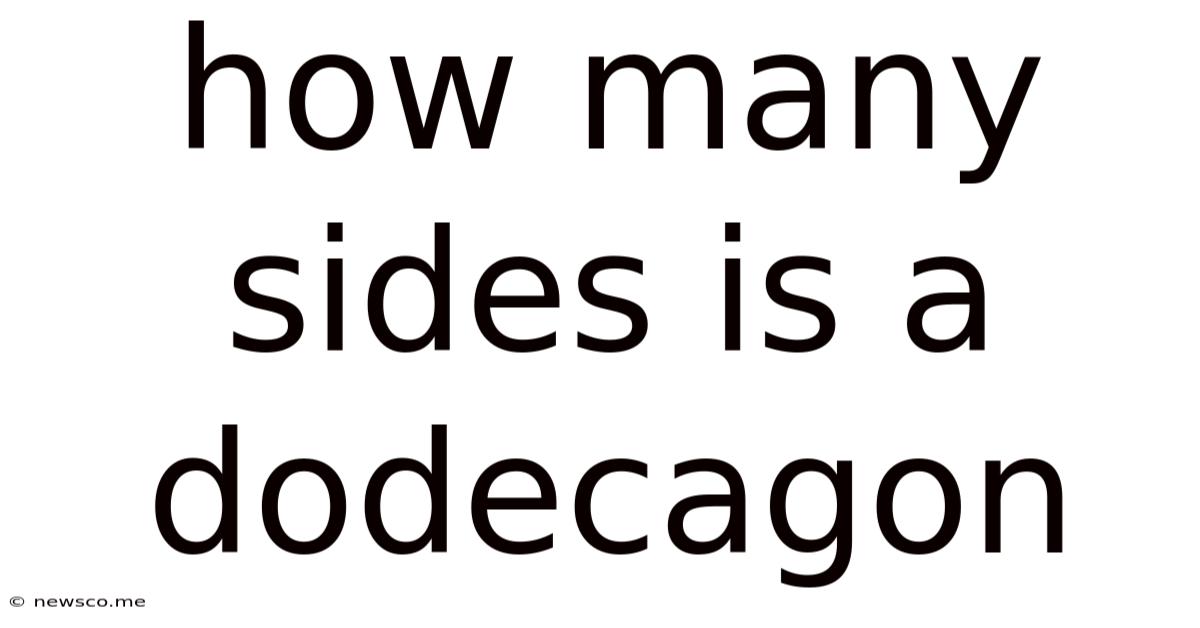How Many Sides Is A Dodecagon
News Co
Mar 30, 2025 · 5 min read

Table of Contents
How Many Sides Does a Dodecagon Have? A Deep Dive into Geometry
The question, "How many sides does a dodecagon have?" might seem simple at first glance. The answer, of course, is twelve. However, exploring this seemingly straightforward question opens the door to a fascinating journey into the world of geometry, exploring its history, properties, and applications. This article will delve deep into the dodecagon, examining its definition, properties, different types, formulas related to it, and its presence in art, architecture, and nature.
Understanding Polygons and the Dodecagon
Before we fully understand the dodecagon, let's establish a foundational understanding of polygons. A polygon is a closed two-dimensional figure formed by connecting three or more straight line segments. These segments are called sides, and the points where they meet are called vertices or corners. Polygons are classified based on the number of sides they possess.
Some common polygons include:
- Triangle: 3 sides
- Quadrilateral: 4 sides
- Pentagon: 5 sides
- Hexagon: 6 sides
- Heptagon (or Septagon): 7 sides
- Octagon: 8 sides
- Nonagon: 9 sides
- Decagon: 10 sides
- Hendecagon (or Undecagon): 11 sides
- Dodecagon: 12 sides
The dodecagon, therefore, is a polygon with twelve sides and twelve angles. This seemingly simple definition leads to a wealth of mathematical properties and real-world applications.
Properties of a Dodecagon
A dodecagon, like all polygons, exhibits several key properties:
1. Interior Angles:
The sum of the interior angles of any polygon can be calculated using the formula: (n - 2) * 180°, where 'n' is the number of sides. For a dodecagon (n = 12), the sum of its interior angles is: (12 - 2) * 180° = 1800°.
If the dodecagon is regular, meaning all its sides and angles are equal, each interior angle measures 1800° / 12 = 150°.
2. Exterior Angles:
The sum of the exterior angles of any polygon, regardless of whether it's regular or irregular, always equals 360°. In a regular dodecagon, each exterior angle measures 360° / 12 = 30°.
3. Diagonals:
A diagonal is a line segment connecting two non-adjacent vertices of a polygon. The number of diagonals in a dodecagon can be calculated using the formula: n(n - 3) / 2, where 'n' is the number of sides. For a dodecagon, this is 12(12 - 3) / 2 = 54 diagonals.
4. Area:
Calculating the area of a dodecagon depends on whether it's regular or irregular. For a regular dodecagon with side length 's', the area can be calculated using the formula: 3(2 + √3)s²/2. For irregular dodecagons, more complex methods are needed, often involving breaking the shape down into smaller triangles.
5. Symmetry:
Regular dodecagons possess a high degree of symmetry. They have twelve lines of reflectional symmetry and twelve rotational symmetries. This symmetrical nature contributes to their aesthetic appeal and frequent use in design.
Types of Dodecagons
While the term "dodecagon" generally refers to a twelve-sided polygon, there are variations:
- Regular Dodecagon: All sides and angles are equal. This is the most commonly visualized dodecagon.
- Irregular Dodecagon: Sides and angles are of varying lengths and measures. There's an infinite number of possible irregular dodecagons.
- Convex Dodecagon: All interior angles are less than 180°.
- Concave Dodecagon: At least one interior angle is greater than 180°. This creates an inward-pointing angle.
The Dodecagon in Real-World Applications
The dodecagon's unique properties and symmetrical nature have led to its appearance in various aspects of life:
1. Architecture and Design:
The dodecagon's symmetrical form lends itself well to architectural and design applications. It's been used in building floor plans, creating tessellations, and designing decorative elements. Think of tiling patterns, stained glass windows, and even certain aspects of building structures.
2. Art and Nature:
The dodecahedron (the three-dimensional counterpart of the dodecagon) is found in nature, specifically in some crystal structures. While not as prevalent as other shapes, the dodecagon's inherent beauty makes it a subject of artistic expression, appearing in paintings, sculptures, and other creative works.
3. Games and Puzzles:
The dodecagon's unique shape finds its way into games and puzzles, providing a challenging and visually interesting element.
4. Mathematics and Geometry:
Beyond its basic definition, the dodecagon serves as a valuable tool in exploring concepts within geometry, such as tessellations, symmetry, and the relationships between polygons and their properties.
Further Exploration: The Dodecahedron
It's impossible to discuss the dodecagon without mentioning its three-dimensional counterpart, the dodecahedron. A dodecahedron is a three-dimensional solid with twelve pentagonal faces, twenty vertices, and thirty edges. Like its two-dimensional counterpart, it exhibits remarkable symmetry and has fascinated mathematicians and scientists for centuries. Its relationship to the Golden Ratio adds to its mathematical significance.
Conclusion: Beyond the Simple Answer
The seemingly simple question of "How many sides does a dodecagon have?" reveals a rich tapestry of mathematical concepts, real-world applications, and aesthetic appeal. From its basic properties to its presence in architecture, art, and nature, the dodecagon stands as a testament to the beauty and complexity inherent in geometry. Understanding the dodecagon goes beyond memorizing the number twelve; it involves grasping its properties, appreciating its symmetry, and recognizing its impact across various disciplines. The next time you encounter a dodecagon, remember that it's more than just a twelve-sided shape – it's a fascinating geometric object with a story to tell.
Latest Posts
Related Post
Thank you for visiting our website which covers about How Many Sides Is A Dodecagon . We hope the information provided has been useful to you. Feel free to contact us if you have any questions or need further assistance. See you next time and don't miss to bookmark.